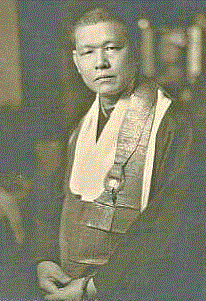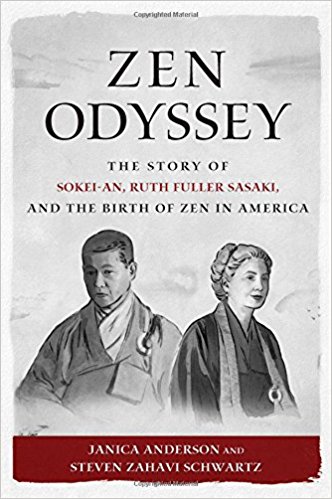ZEN MESTEREK ZEN MASTERS
« Zen főoldal
« vissza a Terebess Online nyitólapjára

曹渓庵 Sōkei-an (1882-1945)
佐々木 指月 Sasaki Shigetsu [宗岑 Sōshin]
born 佐々木 栄多 Sasaki Yeita
Sōkei-an Sōshin Taikō Chōrō Zenji
In the official record, Sasaki was listed as Sōshin Taikō 宗岑大纲
http://en.wikipedia.org/wiki/Sokei-an
http://www.firstzen.org/sokeian.php
Sokei-an studied sculpture and graduated from the Imperial Academy of Art in Tokyo. At the same time he undertook Zen study with the Rinzai Zen master Sokatsu Shaku. Sokatsu, a Dharma heir of the noted Zen masters Soyen Shaku and Kosen, was continuing their interest in attracting educated lay people to Zen. Drafted for the Sino -Japanese War, at war's end Sokei-an married and accompanied Sokatsu to California with the mission of building America's first Zen center. This initial endeavor ultimately failed, and Sokatsu and the other students returned to Japan in 1910. Sokei-an stayed on with his wife, Tomeko, and their three children, working various jobs in the western US., selling subscriptions to and writing a column for a Japanese-American newspaper. Journalist, poet and sculptor, Sokei-an wandered the American West in a restless search for the the American character and the meaning of Zen, the original Dharma bum. His wife, however, did not care for America and eventually returned to Japan with the children.
Settling into Washington Square as the exotic Japanese poet, Sokei-an became part of that emerging bohemian scene. He worked with Maxwell Bodenheim translating poems from Chinese to English, and began writing stories about his experiences. Of particular interest to New Yorkers are the observant tales of Manhattan life in the early part of the twentieth century. Sokei-an wrote about America for Japanese magazines and published four books of ironic essays with titles like "America, a Land Troubled by Money and Women". During the 1920's Sokei-an also supported himself repairing antiques, and published two volumes of poems. He returned to Japan several times to complete his formal Zen training, and received Dharma transmission from Sokatsu, founding the Buddhist Society of America (now the First Zen Institute of America) in New York on West 70th Street in 1930. During the next decade Sokei-an offered a mixture of koan study and lectures on Buddhist and Zen texts based on his own translations to a group of dedicated students.
Shortly before Japan attacked Pearl Harbor in 1941, the organization moved into the home of Ruth Fuller, a Chicago heiress and longtime Zen practitioner. Following the outbreak of the Pacific War, Sokei-an was interned at Ellis Island and was later sent to a camp in Fort Meade, MD. He was released in 1943, subsequently married Ruth Fuller, and resumed teaching Zen until his death in 1945.
Envisioning the life of a Japanese immigrant during the racially divisive period of the early twentieth century, one might assume Sokei-an would have been embittered by his experiences and by the difficulty of bringing Zen to New Yorkers. But Sokei-an was a charming gentleman who bore his dificulties with dignity. His voice still resonates with Western students today, a window onto the bringing of Zen to America at the great crossroads of East and West in the twentieth century.
http://www.firstzen.org/ZenNotes/
PDF: Original Nature: Zen comments on the Sixth Patriarch's Platform Sutra
Translation and commentary by Sokei-an Sasaki
Edited by Mary Farkas, Robert Lopez, Peter Haskel
The First Zen Institute of America, iUniverse, Bloomington, 2010, 2012
PDF: Three-Hundred-Mile Tiger: The Record of Lin-Chi Translation and Commentary by Sokei-An
by Sokei-An Sasaki
Edited by Mary Farkas, Robert Lopez, Peter Haskel
iUniverse, Bloomington, 2013, 394 pages
Sokei-an translated the Record of Lin-chi (Lin-chi lu) from 1931 to 1933, in his first series of lectures. He felt that Americans needed original Chinese Zen source materials, translated and commented upon by a Zen master, and there were no such materials in those early days. Sokei-an was the first Zen master to translate the Record of Lin-chi and to give a commentary in English to Western students. The real historic value of Sokei-an's Lin-chi is in his commentary with its manifestation of Lin-chi's Zen.

PDF: Zen Odyssey: The Story of Sokei-an, Ruth Fuller Sasaki, and the Birth of Zen in America
by Janica Anderson, Steven Zahavi Schwartz
Wisdom Publications, 2018, 384 p.
Sokei-an's Dharma Lineage
[…]
白隱慧鶴 Hakuin Ekaku (1686-1769)
峨山慈棹 Gasan Jitō (1727-1797)
隱山惟琰 Inzan Ien (1751-1814)
太元孜元 Taigen Shigen (1768-1837)
儀山善來 Gisan Zenrai (1802-1878)
洪川宗温 Kōsen Sōon (1816-1892) [今北 Imakita]
洪岳宗演 Kōgaku Sōen (1859-1919) [釋 / 釈 Shaku]
輟翁宗活 Tetsuō Sōkatsu (1870-1954) [釋 / 釈 Shaku]
指月宗岑 Shigetsu Sōshin (1882-1945] [曹渓庵 佐々木 Sōkei-an Sasaki]
In the official record, Sasaki was listed as 宗岑大纲 Sōshin Taikō